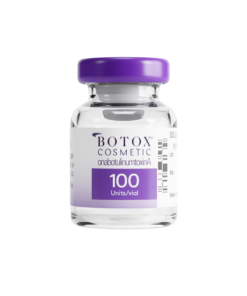Botox Cosmetic Injections (Onabotulinum toxin A)
$410.00 – $850.00
What to know before buying or using Botox Injections
Overview – Botox Cosmetic Injections Onabotulinum toxin A for Injection
Botox Injections are a medical procedure that involves injecting a toxin called botulinum toxin or Onabotulinum toxin A into specific muscles in order to temporarily paralyze or weaken them. This treatment is commonly used for both cosmetic and medical purposes.
Cosmetic Use of Botox Injections
Botox injections are primarily known for their cosmetic use in reducing the appearance of wrinkles and fine lines on the face. The botulinum toxin works by blocking the nerve signals that cause muscle contractions, which in turn relaxes the muscles and smooths out the overlying skin. Common areas for Botox injections include the forehead, between the eyebrows (glabellar lines), and around the eyes (crow’s feet).
Medical Use of Botox Injections
Botox injections also have various medical applications. For example, they can be used to treat conditions such as:
- Migraine headaches: Botox injections can help alleviate chronic migraines by blocking pain signals in the nerves.
- Hyperhidrosis: Botox injections can reduce excessive sweating by inhibiting the sweat glands.
- Muscle spasms: Botox injections can be used to treat muscle spasms and conditions like cervical dystonia (involuntary neck muscle contractions) or blepharospasm (involuntary eyelid twitching).
- Strabismus: Botox injections can be used to treat crossed eyes (strabismus) by weakening the overactive eye muscles.
Procedure and Effects
Botox injections are typically performed by a trained healthcare professional, such as a dermatologist or plastic surgeon. The procedure involves injecting a small amount of botulinum toxin into the targeted muscles using a fine needle. The effects of the injections are not immediate and may take a few days to become noticeable. The results are temporary and usually last for several months, after which further injections may be required to maintain the desired effect.
Side Effects and Precautions
While Botox injections are generally considered safe and effective, there are some potential side effects and precautions to be aware of. Common side effects include temporary redness, swelling, or bruising at the injection site. Other possible side effects can include headache, flu-like symptoms, or drooping of the eyelid or eyebrow.
It is important to consult with a qualified healthcare professional to discuss any potential risks or concerns before undergoing Botox injections. They can provide personalized advice and determine if this treatment is suitable for your specific needs and medical history.
Please note that the information provided here is for general informational purposes only and should not be considered as medical advice. It is always recommended to consult with a healthcare professional for personalized guidance and information about Botox injections.
The medicine in Botox injections is made from the same toxin that causes a type of food poisoning called botulism. But the forms of purified botulinum toxin used by licensed health care providers meet medical control standards. These standards were approved by the U.S. Food and Drug Administration. As a rule, the bacteria toxins used for medical purposes are not harmful if used correctly.
Why it’s done
Botox shots block certain chemical signals from nerves that cause muscles to contract. The most common use of these injections is to relax the facial muscles that cause frown lines and other facial wrinkles.
Botox injections also are used to ease symptoms of some health conditions. It’s not a cure. Examples of medical conditions that might be treated with Botox injections include:
- Neck spasms. In this painful condition, the neck muscles contract in an uncontrolled way. This causes the head to twist or turn into an uncomfortable position. The condition also is called cervical dystonia.
- Other muscle spasms. Cerebral palsy and other conditions of the nervous system can cause the limbs to pull in toward the center of the body. Muscle spasms also can cause eye twitching.
- Lazy eye. The most common cause of lazy eye is an imbalance in the muscles used for moving the eye. Lazy eye also is called crossed eyes or misaligned eyes.
- Sweating. Botox might be used for a condition in which people sweat a lot even when they’re not hot or working up a sweat. It’s called excessive sweating or hyperhidrosis.
- Migraine. Botox injections may help reduce how often you get a migraine. This treatment is used mainly for people who have headaches 15 or more days a month. When you get serious headaches that often, the condition is called chronic migraine. Treatment is needed about every three months to retain the benefit.
- Bladder problems. Botox shots can also help reduce urinary incontinence caused by an overactive bladder.
Risks
Botox injections are usually safe when you’re under the care of a licensed and skilled health care provider. The procedure can result in unwanted results or even cause harm if it’s given incorrectly. Possible side effects and unwanted results include:
- Pain, swelling or bruising at the injection site.
- Headache or flu-like symptoms.
- Droopy eyelids or crooked eyebrows.
- A crooked smile or drooling.
- Watery or dry eyes.
- Infection at the injection site.
Rarely, the medicine may spread to parts of the body where it isn’t supposed to go. It can cause symptoms there. Call your health care provider right away if you have any of these symptoms hours or weeks after your procedure:
- Muscle weakness.
- Vision problems.
- Trouble talking or swallowing.
- Breathing problems.
- Allergic reaction.
- Loss of bladder control.
As a rule, health care providers don’t recommend Botox if you’re pregnant or breastfeeding.
Select your health care provider carefully
Botox is a prescription medicine and must be used only under the care of a licensed and skilled health care provider. Talk with your health care provider about whether the procedure fits your needs.
To find an expert in Botox injections, ask for a referral from your primary care provider.
| UNITS | 50 units, 100 units |
|---|








Reviews
There are no reviews yet.